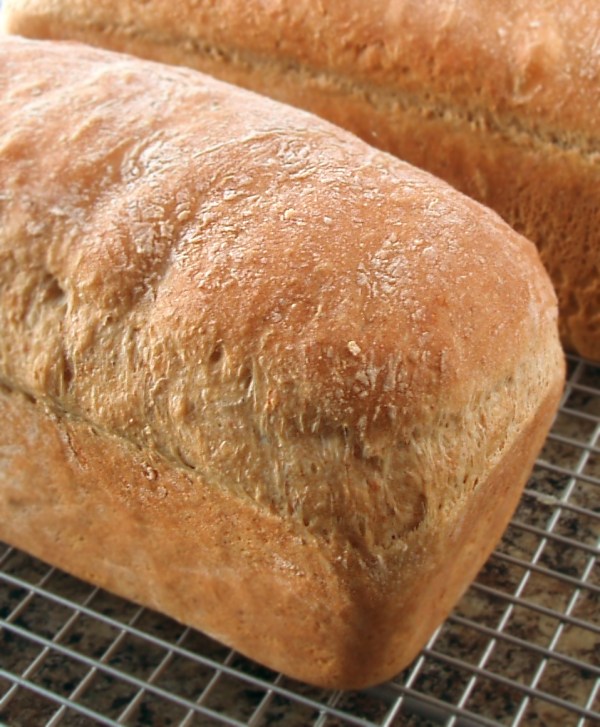It was difficult to maintain our normal cooking and baking activities last month whilst our kitchen was being pulled apart and rebuilt. Although I was usually able to put something together from scratch in a casserole pot for our evening dinner, we did have to resort to buying the plastic-wrapped, pre-sliced stuff that for some unknown reason is commonly referred to as ‘bread’.
I missed my homemade bread greatly during this time and actually couldn’t bring myself to put any of the supermarket variety in my trolley on shopping trips. Poor O became used to my evening phone calls to him at work, confessing that we had run out of bread and could he pick some up on his way home?
Once the builders were gone, I still didn’t feel able to make any bread until the dust had settled a little. I know that some input from the local environment may be desirable in breadmaking, but I didn’t think the sentiment extended to particles of plaster from our ceiling. And so, for these last few weeks, I have been waiting somewhat impatiently for an opportunity to get my hands sticky again in bread dough.
Whilst I was twiddling my thumbs, I discovered some locally-grown and stoneground wholemeal flour in a local farm shop. I can imagine now that anyone who knows this area of Devon is picturing me at Dart’s Farm, buying flour from Otterton Mill 😉 . As wonderful as those places are, I was on an alternative tourist route. I was at the up-and-coming Greendale Farm Shop (which I still prefer to think of as Random Poultry – it’s a much snazzier name) and the flour was from Sidbury Watermill.
Being a numpty, I managed to return home with a packet of plain rather than strong wholemeal flour for my long-awaited loaves. Believing also in the sparkles of serendipity, I’m now looking forward to trying out some wholemeal cakes and pastries. However, I can also confirm for any other numpties out there that Sidbury Mill’s stoneground, plain, wholemeal flour is perfectly adapted for giving a ‘wholemealy’ bite to homemade, soft sandwich bread.

I can probably call the recipe my own, although it is through the genius of far more knowledgeable bakers than myself that I’ve been able to end up with this amalgamation of ingredients and quantities. It is very much an ongoing work-in-progress as I seek to find a sandwich loaf that my husband prefers to those plastic things in plastic wrappings that you find on supermarket shelves.

Wholemeal Sandwich Bread
18 oz water
20 oz strong white flour
1 x 7g sachet instant yeast
6 oz stoneground plain wholemeal flour
4 oz plain white flour
1 egg
1 oz butter
1 tbsp salt
1 tsp barley extract
1 1/2 tsp natural molasses sugar
In a large bowl, mix 10 oz of the strong white flour with all of the water and half of the yeast. Whisk to create bubbles in the batter.
Combine the remaining yeast with the remaining flours and sprinkle on top of the batter so that it is entirely covered. Cover the bowl with clingfilm and leave at room temperature for between 1 and 4 hours.
Add the remaining ingredients to the bowl and stir with a big wooden spoon until all the dry stuff is moistened. Scrape out onto the worktop and cover with the upturned bowl. Leave it all like this for about 15 minutes so that the dough becomes less sticky.
After resting, the dough will still be quite wet but it shouldn’t stick to your fingers too much. Flour your hands if it does, but don’t add too much extra flour at this stage.
If you’re like me and only have one bowl large enough for breadmaking, cover the resting dough with clingfilm while you wash out the bowl and grease it with a little olive oil. Otherwise, go ahead and prepare your oiled bowl at any point before now.
Knead the dough for 8 to 10 minutes. Place it in the oiled bowl and cover with clingfilm. Leave it until doubled in volume, about 1 1/2 hours.
Divide as required, shape and place in loaf tins. I use two loaf tins – a small tin that holds 3 cups of water and a larger tin that holds 7 cups of water. M thinks I make a Mummy loaf and a baby loaf 😉 .
Cover (I like to flour my clingfilm now before covering the tins so that it doesn’t stick to the dough when I forget to take it off early enough as it is rising) and leave until doubled in volume (this happens more quickly in my baby tin).
Bake at the bottom of the oven for 10 minutes at 220 degrees C, then lower the temperature to 200 degrees C and bake for a further 20 to 30 minutes (or 15 minutes for really babyish loaves). Turn out and stand on a wire rack to cool.
I’m sending these loaves to Susan for her weekly showcase of all things bread, YeastSpotting.








Jeannette
/ February 23, 2009I know what you mean about being loathe to put plastic bread in your trolley, I feel exactly the same! Pleased to say I haven’t bought that kind of ‘bread’ for years now. However, I don’t always hand make it myself, i use a Panasonic machine. I used to be ashamed of admitting to this but I think it is better than buying rubbish, at least I know what goes into my dough! I do also hand make bread doughs when I want something a bit different, for instance i just had a go at the dough from Artisan Bread in 5 Minutes, a cheesy bread which was very tasty.
Love the new look of your blog, very smart and clean looking! See you soon I hope at the aforementioned Dart’s Farm! My daughter and family were there on Saturday.
amerrierworld
/ February 23, 2009We did have a bread machine once upon a time (when O was the major chef in the house) … it’s probably in the garage somewhere. I liked the wholegrain and seeded breads it made, but I could never get it to make a nice, white loaf. They always tasted way too sweet for me. I tried cutting back on the sugar in the recipe, but it was a bit of a disaster – as you can imagine!! Also, I was never keen on bread with a big hole in its bottom (or side … they were very peculiarly-shaped loaves). When I started making bread here in Devon, I thought it would be important to get a feel for the entire process by hand before using any mixers etc. I still don’t feel experienced enough to graduate (besides, the girls know they can’t bother Mum when she’s got sticky dough on her hands … so making bread by hand gives me a bit of time out, too 😉 ).
Very much looking forward to our Dart’s Farm meetup (I hope you remembered to put the date in your 2009 diary!).
Jeannette
/ February 23, 2009Sorry, I didn’t know we had an actual date! I’ve just got sometime in May earmarked. perhaps you can e-mail me with more info.
Mallika
/ February 23, 2009It looks lovely. I too can’t stand the supermarket stuff, but it’s the farmer’s market loaves I opt for.
anne
/ February 26, 2009Your bread looks delicious, I really like using the stoneground wholemeal flour in breads, find it gives more flavour and texture. Will definately snag when I get round to buying a replacement loaf tin… 🙂
amerrierworld
/ February 26, 2009Jeannette, YGM 🙂
Thanks, Mallika and Anne. It seems to have passed the husband-test this time – he’s asked for more of this bread!
Susan/Wild Yeast
/ February 27, 2009Beautiful loaf, now I am craving a sandwich! Thanks for participating in YeastSpotting!
amerrierworld
/ February 27, 2009Thanks, Susan. I’m looking forward to working my way through your weekly round-ups 🙂 .
Nancy (n.o.e.)
/ February 28, 2009I love the look of this bread, and I’ll wager that it tastes just as wonderful. I’m making notes of your recipe.
Nancy
amerrierworld
/ February 28, 2009Thanks for your kind comment, Nancy. I’d love to hear what you think of the bread if you do make it 🙂 .
Stefanie
/ February 28, 2009What a beautiful loaf!